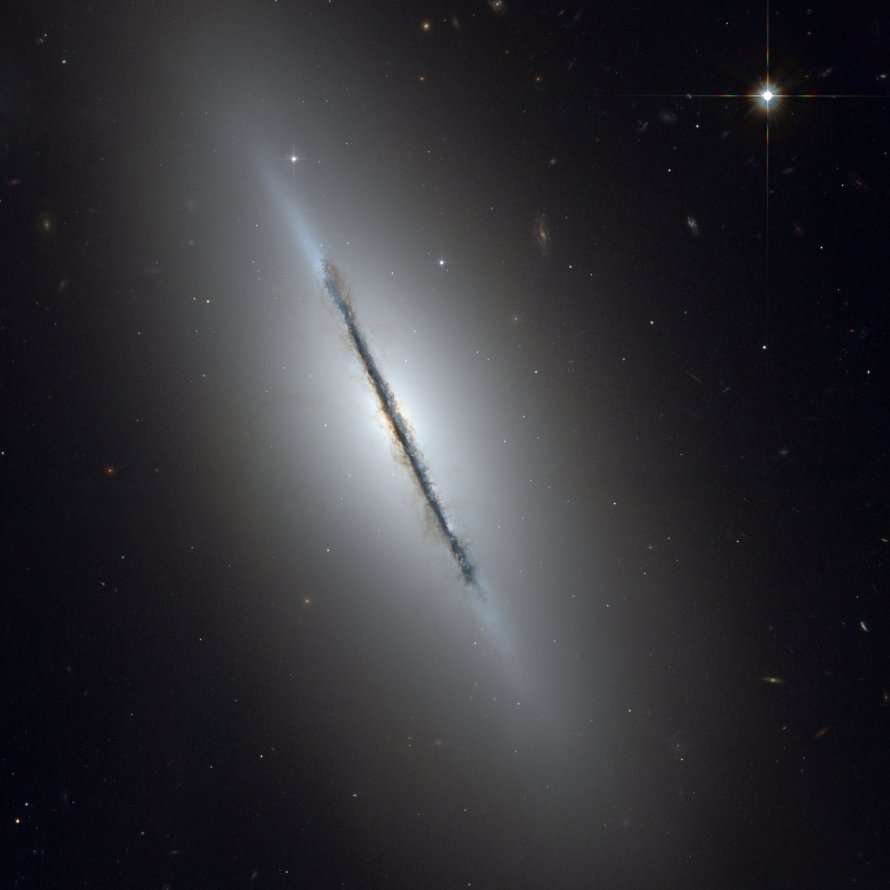M102 (NGC 5866) - Spindle Galaxy
Messier 102 (NGC 5866), also known as the Spindle Galaxy, is a lenticular galaxy located in the constellation Draco in the M102 Group of galaxies. M102 is 50000000 light years away from Earth.
M102 is best viewed during mid-summer, is magnitude 10.7, and can be viewed with small telescope. M102 is 4.7' x 1.9' in apparent size. For reference, the full moon is 30'.
Observing difficulty: Intermediate
- Name:
- Spindle Galaxy
- Type:
- lenticular galaxy
- Constellation:
- Draco
- NGC or IC:
- NGC 5866
- Magnitude:
- 10.7
- Viewing:
- small telescope
- Size:
- 4.7' x 1.9'
- Distance (light years):
- 50000000 LY
- RA:
- 15h 6.5m
- Dec:
- 55 45'
- Season:
- mid-summer
- Galaxy group:
- M102 Group
- Messier Marathon #:
- 45
* The naked eye can see up to magnitude ~7-8 objects under ideal dark sky conditions.
The Spindle Galaxy
Messier 102 (M102), also known as the Spindle Galaxy, is an edge-on lenticular or unbarred spiral galaxy located in the northern constellation Draco. There's an ongoing controversy about its true identity, with some astronomers arguing that M102 is actually a duplicate entry of Messier 101, or possibly could be identified as NGC 5866. This article focuses on NGC 5866, which is the most accepted candidate for M102 among the astronomical community. It was discovered by Pierre M?chain in 1781, who described it as a "nebula between the stars Omicron Bootis and Iota Draconis".
Physical Characteristics of Messier 102
Assuming M102 to be NGC 5866, the galaxy features a prominent dust lane that is visible along the edge of its outer disk, an uncommon trait for lenticular galaxies and one of the reasons some argue it's an edge-on spiral galaxy. The galaxy has a relatively bright central bulge and tapering, fainter outer edges. The dark dust lane is punctuated by regions of active star formation, visible as brighter patches along the galaxy's edge.
M102 is somewhat isolated, having only a few small companion galaxies in its vicinity. The gravitational interactions with these companions may have played a part in shaping the distinctive dust lane and the galaxy's overall structure.
Magnitude and Distance
The Spindle Galaxy is located approximately 50 million light-years away from Earth. It has an apparent magnitude of 10.7, making it a fairly dim object that is not visible to the naked eye. However, its high surface brightness compared to other galaxies of similar magnitude makes it a good target for amateur telescopes.
Finding and Observing Messier 102
M102 lies in the constellation Draco, the Dragon, near its border with the constellation Bo?tes. It's situated roughly between the stars Mizar in Ursa Major and Eta Ursae Minoris in Ursa Minor. While the Spindle Galaxy is not visible to the naked eye, it can be observed using a small to medium-sized telescope under dark skies.
Under good viewing conditions, observers may note the elongated shape of the galaxy and the brighter central region. The prominent dust lane, however, is a challenge to see and typically requires larger telescopes and excellent viewing conditions to discern. Long-exposure astrophotography can reveal the dust lane and other subtle features in more detail.
Despite the uncertainty surrounding its identification, M102 (NGC 5866) offers a fascinating glimpse into the complex and diverse structures that galaxies can possess. Its distinctive dust lane and relative isolation make it a compelling object of study for both amateur and professional astronomers.



